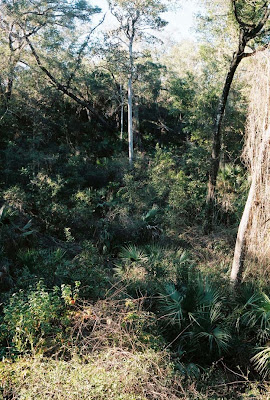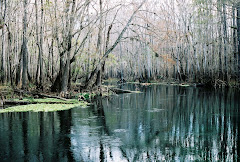While out looking at riverfront properties, along the bucolically sublime shores of Econofina Creek in northern Bay County, we stumbled upon a beautiful hiking trail through an old growth forest. It is a 2-mile loop that starts out in the densely wooded bottomlands of the Econfina floodplain where it passes under Florida Hwy. 20 at the Pitt Spring recreation area. From there the trail gradually climbs up onto an 80-foot bluff overlooking the winding creek below before descending back down to the swampy bottoms and eventually back to the Pitt Spring parking area.
The trail winds through a forest that contains many giant specimens of beech, oak and cypress, some of which towered almost 100 feet above us. We spotted a large crested woodpecker which we thought was a pileated but after giving a description to a birder friend of mine he suspected that we may have actually stumbled upon an ivory-billed. Such a discovery would make us famous celebrities in the naturalist world. I'm still quite sceptical but my friend has urged me to return and see if I can get another good look and maybe even a picture.
The last reported sighting of this supposedly extinct bird was in this very same part of Florida last year. In 2004 a team of Cornell University ornithologists claim to have made a positive sighting in the woody swamps of southern Arkansas and before that the last documented ivory-billed woodpecker recorded was in Louisiana in 1944.
The trailhead is located at the Pitt Spring recreation pool located along Florida Hwy. 20 where it crosses Econfina Creek about 25 miles north of Panama City and eight miles east of U.S. Hwy. 231.








































